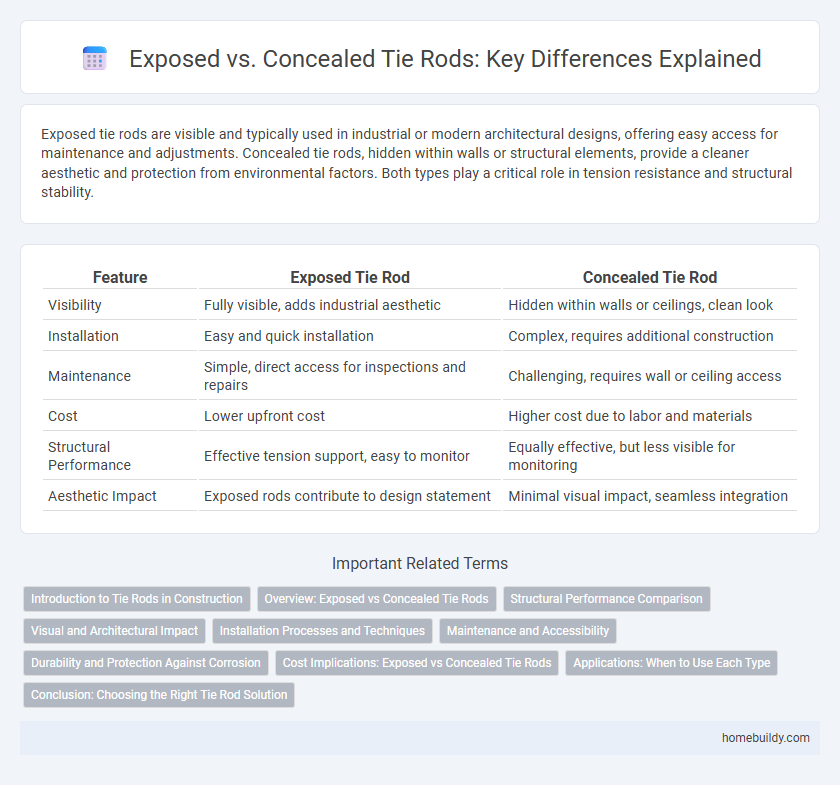Exposed tie rods are visible and typically used in industrial or modern architectural designs, offering easy access for maintenance and adjustments. Concealed tie rods, hidden within walls or structural elements, provide a cleaner aesthetic and protection from environmental factors. Both types play a critical role in tension resistance and structural stability.
Table of Comparison
| Feature | Exposed Tie Rod | Concealed Tie Rod |
|---|---|---|
| Visibility | Fully visible, adds industrial aesthetic | Hidden within walls or ceilings, clean look |
| Installation | Easy and quick installation | Complex, requires additional construction |
| Maintenance | Simple, direct access for inspections and repairs | Challenging, requires wall or ceiling access |
| Cost | Lower upfront cost | Higher cost due to labor and materials |
| Structural Performance | Effective tension support, easy to monitor | Equally effective, but less visible for monitoring |
| Aesthetic Impact | Exposed rods contribute to design statement | Minimal visual impact, seamless integration |
Introduction to Tie Rods in Construction
Tie rods are crucial structural components used to provide tension and stability in construction frameworks, commonly found in bridges, roofs, and buildings. Exposed tie rods offer easy inspection and maintenance but may require protective coatings to prevent corrosion, while concealed tie rods enhance aesthetic appeal and protect the rod from environmental damage, often integrated within walls or beams. Selecting between exposed and concealed tie rods depends on factors like structural requirements, durability, and architectural design preferences.
Overview: Exposed vs Concealed Tie Rods
Exposed tie rods are visible components often used in traditional architectural styles for their aesthetic appeal and ease of inspection, while concealed tie rods are embedded within walls or ceilings, providing structural support without affecting interior design. Exposed tie rods allow for straightforward maintenance and adjustment but may be vulnerable to environmental elements, whereas concealed tie rods offer protection and a cleaner appearance, contributing to enhanced safety and durability. The choice between exposed and concealed tie rods depends on factors such as building design, maintenance accessibility, and structural requirements.
Structural Performance Comparison
Exposed tie rods provide superior ease of inspection and maintenance but are more susceptible to environmental corrosion, affecting long-term structural integrity. Concealed tie rods offer enhanced aesthetic appeal and protection from external elements, leading to improved durability and consistent load distribution. Structural performance favors concealed tie rods in adverse conditions, while exposed tie rods facilitate early detection of stress or damage.
Visual and Architectural Impact
Exposed tie rods contribute a raw, industrial aesthetic that highlights structural elements as part of the interior design, often enhancing modern or loft-style spaces. Concealed tie rods maintain clean, uninterrupted surfaces, preserving a minimalist and refined architectural appearance by hiding mechanical components within walls or ceilings. Choosing between exposed and concealed tie rods significantly influences the overall visual harmony and design intention of a building.
Installation Processes and Techniques
Exposed tie rods typically require surface mounting using brackets or clamps, simplifying access for adjustment and maintenance but demanding precise alignment during installation to ensure proper function. Concealed tie rods are embedded within structural elements or walls, necessitating careful planning and coordination with construction phases to avoid damaging surrounding materials. Installation of concealed tie rods involves specialized tools and techniques for secure anchoring and often includes protective coatings to prevent corrosion over time.
Maintenance and Accessibility
Exposed tie rods allow for easier inspection and routine maintenance due to their visible placement, enabling quick identification of wear or damage without dismantling components. Concealed tie rods, while offering aesthetic and protective benefits, often require more labor-intensive access procedures, increasing maintenance time and complexity. Accessibility directly impacts maintenance efficiency, with exposed tie rods reducing downtime and facilitating timely adjustments or replacements.
Durability and Protection Against Corrosion
Exposed tie rods are more susceptible to environmental elements, which can accelerate corrosion and reduce durability compared to concealed tie rods. Concealed tie rods benefit from protective coverings or enclosures that shield them from moisture, dirt, and chemicals, significantly enhancing their longevity. The use of corrosion-resistant materials and coatings further improves the lifespan of tie rods, with concealed designs offering superior protection in harsh conditions.
Cost Implications: Exposed vs Concealed Tie Rods
Exposed tie rods typically involve lower initial costs due to simpler installation and easier access for maintenance, making them a cost-effective option for many construction projects. Concealed tie rods, while more expensive upfront because of additional labor and materials required for embedding within structures, offer long-term benefits by reducing corrosion risk and preserving aesthetic appearance. Evaluating the total cost of ownership should consider both the upfront expenditure and potential maintenance savings associated with concealed tie rod systems.
Applications: When to Use Each Type
Exposed tie rods are ideal for applications requiring easy inspection and maintenance, such as industrial machinery and heavy equipment, where quick access to components is crucial. Concealed tie rods suit architectural structures and residential buildings that prioritize aesthetics and protection from environmental elements. Selecting the appropriate tie rod depends on balancing visibility, accessibility, and environmental exposure considerations.
Conclusion: Choosing the Right Tie Rod Solution
Exposed tie rods offer easier inspection and maintenance due to their visibility, making them suitable for applications requiring frequent monitoring. Concealed tie rods provide a cleaner aesthetic and protection from environmental factors, ideal for architectural designs prioritizing appearance and durability. Selecting the right tie rod depends on balancing maintenance accessibility with design requirements and environmental exposure.
exposed tie rod vs concealed tie rod Infographic

 homebuildy.com
homebuildy.com